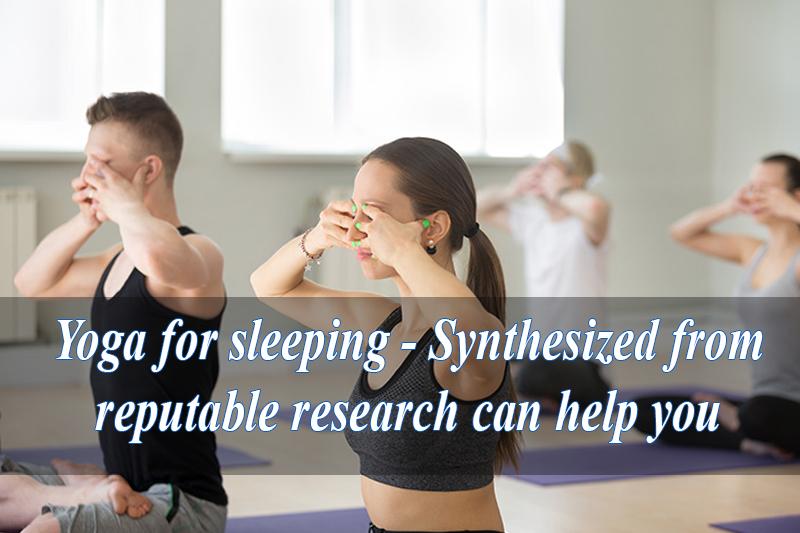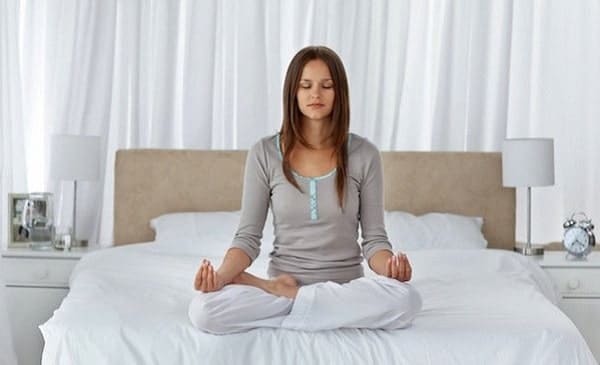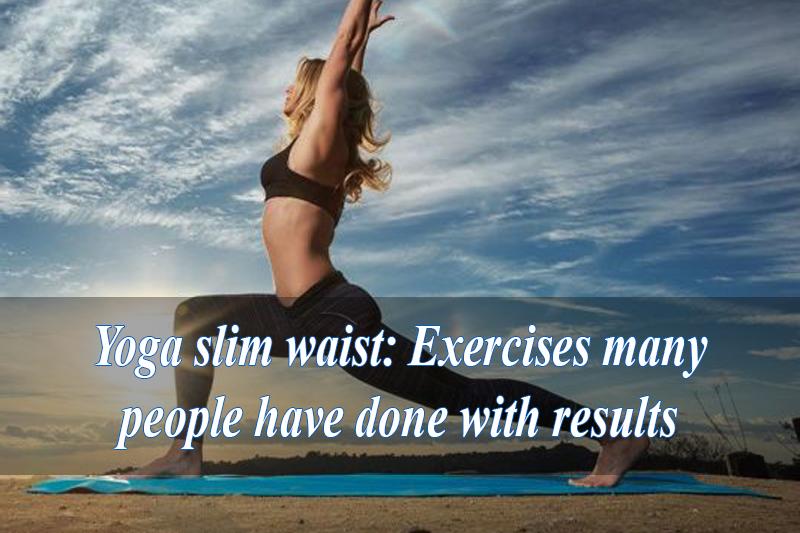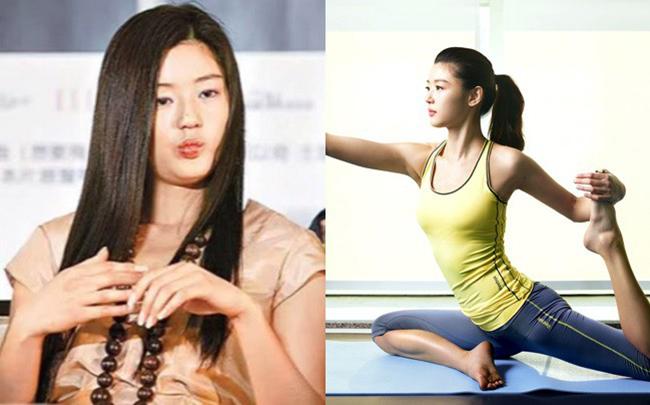Insomnia is one of the causes of a weakened immune system, which is an opportunity for bacteria or viruses to invade.
According to the statistics of recent studies, most cases of insomnia are caused by stress, stress at work and life, people with depression, diabetes, and heart failure… yoga for people with insomnia are exercises to help people sleep well and deeply, relax the mind and improve sleep, great for people with this disease.

The article, Bellyfatzone shares with you good supportive yoga poses: Yoga for sleeping: Synthesized from respected research can help you
Is yoga effective in treating insomnia?
Since its appearance, the benefits of yoga for people with insomnia have been widely known and have become a leading health improvement and anti-aging discipline for all ages.
Many scientific studies show that yoga can improve physical health, breathing, and body flexibility, reduce stress and increase mental focus. Besides, yoga also brings positive effects on sleep.
One study found that yoga for insomnia can help improve sleep in people with chronic insomnia.
Research at Harvard Medical School, USA, looked at how the daily practice of yoga could improve sleep for people with chronic insomnia, and they found some improvements in both physical and mental health quality and duration of sleep.
Another study was conducted on people with different types of insomnia, including those with primary and secondary insomnia. Subjects suffering from insomnia mentioned above will participate in introductory yoga training courses, then maintain daily yoga practice for eight weeks.

Study participants were asked to keep a sleep diary for 2 weeks before the yoga regimen began and throughout the eight-week study period.
After 20 people completed the program, the researchers began analyzing information recorded in their sleep diaries to assess the effects of yoga on chronic insomnia.
The participants in this study perceived positive sleep-related outcomes as:
- Quality of sleep
- Total sleep time
- Total time to wake up
- Sleep onset delay (the amount of time it takes to fall asleep)
- Time to wake up after sleeping
Although yoga for insomnia has not been seen as an intensive treatment for sleep problems and disorders, we have seen various scientific evidence regarding yoga practices for insomnia in recent years. Insomnia is effective in improving sleep.
Also, in a study of 410 cancer survivors giving yogis improved sleep quality, decreased feelings of fatigue, decreased frequency of sleeping pills, and improved quality of life in patients who practiced yoga for two years times a week and a 75-minute session.
Research studies have shown that yoga for insomnia is effective in postmenopausal women and has found that yoga has the potential to reduce the symptoms and severity of sleep disorders.
Yoga exercises for insomnia also reduce stress and have a better sense of improving quality of life. Yoga also has a positive effect on people with osteoarthritis.
How Yoga Helps You Sleep

There are many ways that yoga can lend a hand to support the standard of sleep:
Mindfulness: This is a tradition of judgment-free awareness in the second. Mindfulness is a commonplace part of a wide variety of yoga. Mindfulness can build up melatonin levels and scale back nighttime sleep disturbances in adults.
I am breathing awareness and legislation. These are also parts of yoga. Deep breathing is a leisure methodology that may result in sleep.
Regular exercise. Frequent movement is a crucial element of sleep hygiene. Moderate workouts, several instances a week, can boost overall sleep.
Weight loss: While weight loss may not be the primary objective for some yoga practitioners, shedding pounds may have confident results on sleep. Weight loss can reduce or prevent many sleep issues, such as sleep apnea.
There are also explicit sleep problems that can be undoubtedly impacted by common yoga follow.
Yoga and Insomnia
Insomnia is the inability to go to sleep or stay asleep. Insomnia can have many long-term effects, including daylight sleepiness and impairment, reminiscence loss, and mood changes. Studies have verified that yoga may help handle sleep problems equivalent to insomnia. Yoga can benefit groups of folks with insomnia, corresponding postmenopausal girls, and girls with breast cancers.
Yoga and Restless Leg Syndrome (RLS)
Restless leg syndrome (RLS) is a compulsion to move the legs that are incessantly unsightly or even painful. This urge incessantly happens all through sessions of state of being inactive, akin to the middle of the night. RLS impacts girls greater than men.
In a pilot learn about ladies with RLS, after just eight weeks of yoga categories, their RLS symptoms were considerably alleviated. Sleep, pressure, and general mood have progressed as neatly. While further learn about is needed, those effects recommend that yoga is a positive software to improve sleep in patients with RLS.
Details of 10 yoga exercises for insomniacs
1. Standing forward – bend

This yoga pose for insomnia, where you will stand up straight, and relax your neck, is a standing position that bends the body forward and allows the neck muscles to relax. Not only that, but this pose also gently stretches the calves, thighs, and glutes.
Instructions for performing yoga exercises for insomniacs:
Step 1: Stand with your feet hip-width apart and take a deep breath.
Step 2: Exhale, extend your body and then bend forward, bringing your hands over your legs to lengthen your spine.
Step 3: If you have a toned stomach, keep your knees soft by bending slightly so that your chest can relax on your thighs.
Step 4: Hold your elbows and let your hands rest on your shins or the floor. Then inhale and exhale gently.
Step 5: Gently shake your head to relax and loosen the neck muscles. Finally, roll your body up slowly to avoid dizziness and lightheadedness.
View more: The Ways Use Yoga To Reduce Belly Fat in 1 Week For Perfect Photos
2. Plowshare pose exercise

This exercise has the effect of better blood circulation throughout the whole body. Easily put you to sleep and deep sleep. Plowshare yoga pose. This is yoga for insomniacs that should not be missed.
Do the exercise with the following steps:
Step 1: Lie on your back on the mat.
Step 2: Then raise your leg over your head until it touches your back.
Step 3: Hands behind your back, relax and palms face down on the floor.
Step 4: Hold the pose for 1-5 minutes. Breathe gently back to the original state.
Note: Be careful before doing this yoga for insomnia if you have a back injury.
View more: Practicing Yoga increases the flexibility of the body after the age of 30
3. Wide-knee child's pose

This exercise performed with your knees extended will give your body a rest and help regulate your mood to become more stable and calm.
Instructions for performing yoga for insomniacs in the baby pose are as follows:
Step 1: You kneel on the floor to easily bring your butt to sit on your heels. Slowly extend your upper body forward, then straighten your arms to pull your upper body against the floor and your knees hip-width apart. Next, keep your feet in line with your knees, straighten your feet, and gradually bring your fingers to touch each other.
Step 2: Slowly separate your knees as wide as the edges of the mat. Then exhale and lower your body to the sides of your thighs, letting your buttocks touch the heels of your feet.
Step 3: Relax your hands by placing your hands along your torso and palms facing up. Being in this position will help relieve shoulder tension as the shoulder blades are extended. Or you can relax your arms by reaching forward and placing your hands on the mat.
Step 4: Relax your facial muscles, chin and neck, then gently lower your forehead to the mat and close your eyes, and roll your head slowly to the sides.
Step 5: Breath evenly and slowly, then return to the original position and open your eyes.
View more: Yoga Poses for Beautiful and Toned Thighs
4. Yoga moves for insomniacs – Moon breath

The nostrils are the place to help circulate blood and breath and cool the body. The exercise with the nostrils releases tension, sending signals to the vagus nerve to tell the brain that the body needs rest.
Step 1: Sit comfortably; use your right hand to perform.
Step 2: The index and middle fingers are bent, folded into the palm, straightened the little and ring fingers. Press the right nostril with your thumb, and inhale sharply into the left nostril.
Step 3: Next, remove the thumb and use the ring finger to press on the left nostril, exhale through the right nostril.
Step 4: Perform continuously for about 1-3 minutes to maintain a state of relaxation, comfort, airway circulation, and sleep.
5. Legs up the wall pose

The perpendicular position of resting the foot on the wall will support the treatment of cerebral circulatory disorders. Every day, if you often do many things in a standing position, causing your feet and ankles to swell, this exercise will help your legs relax, reduce pain and bring deeper sleep. You can do this yoga exercise for insomnia in bed.
Implementation Guide:
Step 1: First, lie on your back on a mat or bed to be perpendicular to the floor.
Step 2: Gently place your legs upright and close to the wall. Next, lift your butt and place an extra pillow under your back to let your back relax and feel comfortable.
Step 3: Relax your arms by placing them horizontally or parallel to your body and palms facing down.
Step 4: Hold the pose and breathe evenly for about 2 minutes with this yoga for insomniacs. Then lower your knees, lean over, and sit up to complete the exercise.
View more: What To Eat Before And After Yoga For Weight Loss?
6. Seated forward bend exercise

You do the standing forward bend, a yoga exercise for insomnia, which helps stretch the thighs' hamstrings and flexibility. This yoga pose for insomnia will affect the whole body to help the internal parts of the body to be stretched. Besides, this pose helps to soothe headaches, reduce stress and anxiety, and support the treatment of mild depression and insomnia.
Do yoga for insomniacs as follows:
Step 1: Stand up straight, feet a small distance apart and relax your arms on either side of your body.
Step 2: Inhale and slightly bend your knees and then use your hips to bend forward slowly.
Step 3: Exhale, slowly move the knee from bent to straight and continue to bend forward. Place your hands on the floor or hug your right ankle and leg. Press your chest against your legs to feel the stretch from your hips.
Step 4: Place your head close to your legs and close your eyes to feel the tension of the muscles; hold this position for 15 – 30 seconds. In the end, breathe in and put your hands on your hips, then exhale and slowly raise your body back up to the original upright position.
7. Reclining bound angle

In the yoga exercise for insomnia, the fixed position of lying on the back will support the body's recovery and help expand the hips. This is a basic pose so that anyone can do it.
You do the following exercises:
Step 1: Lie on your back on the floor and slowly bend your knees and bring your feet together to form a fixed angle on the floor, pointing your heels toward your groin.
Step 2: Place your palms near your hips and press them to the floor. Exhale, make sure your lower abs tighten and feel the stretch in your lower back.
Step 3: Hold the pose, exhale gently and inhale, knees extended and feel the stretch in the inner thighs.
Step 4: Relax the entire spine, shoulders, and neck and then hold this position for 1 minute, breathing deeply and slowly.
Step 5: Exhale and press your lower back firmly with your knees to the floor to stretch your muscles and then release your knees and slowly return to the starting position.
View more: How Many Times Should I Practice Yoga a Week?
8. Legs on a chair pose

If you have trouble stretching your legs up the wall when you have a back, knee, or hip injury, you can do yoga for insomnia by placing your feet on a chair. This pose helps to relax your whole body and stabilize your mood during deep breathing.
Instructions for the exercise:
Step 1: First, in this yoga for insomnia, you put a chair on the yoga mat to face.
Step 2: Use a folded towel or soft blanket on the chair. You can also put a folded towel under your head.
Step 3: Place your feet on the chair, and bend your knees so that the calves are at a 90-degree angle to the thighs. You need to roll up for a higher chair so that your calves rest on the chair.
Step 4: Keep your arms at your sides to relax and palms up.
View more: 11 Most Basic Exercises – Self- Practice Yoga at Home Properly
9. Corpse pose

This is a simple pose that is highly effective. This exercise helps to relax the body but also helps regulate blood pressure, and dispel the pressure to bring abundant energy after tired and stressful working hours.
Implementation Guide:
Step 1: First, lie on your back on the floor, without using any pillows or cushions, then relax your whole body and close your eyes.
Step 2: Place your feet a distance apart to ensure comfort and relax your toes. Arms along the body and palms facing up.
Step 3: Gradually shift attention to all body parts from the toes upwards to the top of the head. Breathe slowly and deeply, putting your body into deep relaxation.
Step 4: Continuing to breathe deeply and sincerely will help the body relax completely and forget about other problems.
Step 5: Lie still for 10-12 minutes to feel the relaxation and refreshment. Then turn to the side, hold the position for 1 minute, then sit up.
View more: Basic Yoga Principles For Beginners And Big Mistakes To Avoid Immediately
10. Flame yoga pose exercise

This is a meditation-like pose. Insomniac people sit relaxed, hip muscles relax, and other muscle groups relax; this yoga for insomnia helps the body go deeper to sleep.
Step 1: Place the right foot on top of the left knee so that the right shin rests on the left foot.
Step 2: Put your palms together, place them in front of your chest, and perform regular inhalation and exhalation to circulate blood.
Step 3: Perform for about 1 minute and switch to the other leg.
View more: What yoga exercises should people with low blood pressure do?
Notes when practicing yoga for insomnia:
- Sanitize, and shower thoroughly before practicing yoga.
- During exercise, you should pay attention to breathing evenly and deeply, which will help provide the necessary amount of oxygen to the cells in the body and avoid blood vessel blockage.
- After exercising, it is necessary to maintain a stable body temperature and avoid going out immediately. If you need to go out, keep warm by wearing long-sleeved clothes.
- Besides, it must be combined with a healthy and scientific diet and lifestyle. Limit the habit of smoking, and abusing alcohol, especially before sleeping.
- Pregnant women and people with osteoarthritis and digestive diseases need to consult a doctor for advice and guidance on appropriate yoga poses.
The above article information on Belly Fat Zone and how to practice yoga exercises for insomniacs hope to help those who unfortunately suffer from this disease. In addition to exercising or building a healthy lifestyle and nutrition habits to ensure your health!
References:






